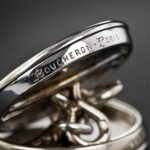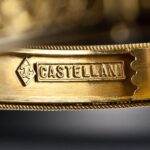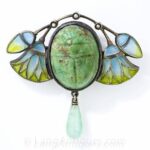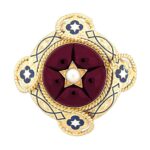
Following the February Revolution in 1848 and the abdication of Louis Phillipe The Second Republic, a provisional government, was established in France. The resulting French Constitution of 1848 included a proviso for Presidential elections to be held every four years. The first election put Louis-Napoléon Bonaparte in the Presidential palace. He enjoyed it so much that, after three years, he arranged a coup d’état setting himself up as the Prince-President, Emperor Napoléon III.
One of Bonaparte’s primary goals was to stimulate the French economy. As part of his economic plan, France hosted the 11th Exposition (Exposition Nationale des produits de l’industrie agricole et manufacturière). Fifty-four hundred ninety-four proud exhibitors displayed their wares on the Champs-Élysée for all the world to admire from June 1, 1849 to July 30, 1849. This granted Bonaparte an international pulpit on which he could begin to legitimize the creation of France’s Second Empire and proclaim Algiers to be annexed to France.
The concurrent proliferation of railways throughout Europe facilitated exhibition attendance from all walks of life and far-flung regions. During this era, prior to the inventions of mass media, television, and the internet, exhibitions such as these provided a mind-boggling perspective on the Arts, Sciences, and Industry to the attendees. They were a well-established French tradition that invariably led to imitators. The most notable example, the Great Exhibition of 1851, was held in London where the French overwhelmingly earned nearly 60% of the prizes. 1 In a speech by Louis Bonaparte during the medal ceremony for the French winners he broadly hinted at the coup d’etat that would proclaim him Emperor just days later.2

Copy from the Original by Franz Xaver Winterhalter, c.1853.
The French jewelry industry stood to make impressive gains from these remarkable events, which included Bonaparte’s marriage to Eugénie de Montijo. The Imperial couple provided the impetus for the opulence of the Second Empire. The elegance and charm of the new Empress were infectious. As the ladies of Paris attempted to emulate her fine fashion sense, the jewelry and fashion industries blossomed. Salons, receptions, and galas required one to have a collection of jewels created uniquely for such events. Receptions at Chateau Compiègnes required “Épaules ou épaulettes” also known as ladies with bare necks and shoulders and gents in uniform with epaulets.3

David Liuzzo, Attribution, via Wikimedia Commons.
Bonaparte had what remained of the crown jewels dismantled and new jewels created to adorn his Empress. Styled with contemporary taste, only those jewelers with in-house workshops were trusted with this unique opportunity.
At the Exposition of 1855, Emperor Napoléon III decreed that the newly restyled Crown Jewels be prominently displayed. This treasure was unparalleled. Even those distinguished in the jewelry world had never seen such a collection of diamonds and colored gems mounted so liberally. This ostentatious display hammered home the Emperor’s love of luxury and his confidence in the jewelers of Paris. Many of the fine jewelers who gained fame during this period, along with those previously established (during the reign of Louis Phillipe), became the jewelers we refer to when we use the expression “Famous Jewelers.”4
Innovations & Discoveries

France’s illustrious Emperor and Empress were setting a fine example of luxury living. Paris became the destination for the world’s aristocrats, crowned heads, and garden variety wealthy. Railway expansion, world trade booming, the imminent opening of the Suez Canal, and an upturn in French industry and tourism resulted in an economic explosion ensuring an impetus for luxury goods.
Gem-set jewelry design stagnated for a long period leading up to the Second Empire. Designs were uninspired, comprising foliate motifs, demi-parures of earrings and brooch, hardstone cameos, and wide gold bracelets. The Empire’s reinvigoration of the public to own and wear jewelry revived the industry despite the lack of imaginative designs. As the cost of creating beautiful gem-set jewels became less important (due in part to high profits in the luxury market) jewelers were free to experiment with larger stones, more diamonds, and less cumbersome settings. The conventional silver-topped gold setting was abandoned for a gold-only setting allowing more delicate arrangements of a greater number of stones and the use of enamel along with the gems. 5

Department of Greek, Etruscan and Roman Antiquities.
© 2009 RMN-Grand Palais (musée du Louvre) / Hervé Lewandowski.
Archaeologists were exploring sites around the world including many in Italy. The Marquis de Campana was an avid collector of the ancient Roman jewels being excavated. He amassed an enviable assortment from these Italian archaeological sites. Having embezzled funds to help pay for these coveted objects, he was forced to liquidate. Napoléon III acquired the collection at a bargain price. Every type of jewelry was represented; necklaces, diadems, fibulae, earrings, rings, and bracelets all elaborately chased or delicately ornamented with filigree. Displayed at the Louvre for all to see, a fashion for this “neo-Greek” style developed among the jewelers of the day as well as the consumers of fine jewels.6
The Chinese expedition in 1860, wherein General Cousin-Montauban, Comte de Palikao captured Peking, resulted in shipments to France of heretofore unseen bright green jadeite. Jeweler Fontenay was anxious to employ this new material, having it cut in Paris for the first time in the Western world. A number of jewels bedazzled with this “emerald green” jade came from Fontenay’s workshop.7
The Egyptian government celebrated the impending opening of the Suez Canal by commissioning Parisian jeweler Halphen to make some commemorative pieces. In order to meet deadlines, Halphen spread the work out among many more Parisian jewelers and, along with it, Egyptian inspiration. The London Exhibition of 1862 provided additional evidence that the jewelers of the Second Empire were inspired by the Egyptian excavations. With the popular jewelers of the era rendering pieces motivated by this ancient jewelry resurrected from the tombs of Egypt, an international craze for the “Egyptian taste” – Egyptomania flourished.8

Personages who Visited the Exhibition Universelle of 1867.
1867 Exposition Universelle
“Detailed descriptions of the most important jewels exhibited in the French section helped to demonstrate the latest trends more accurately; in some ways, the 1867 Exposition was the first flowering of the new diamond-mounting techniques. Gem-setting may have improved since then; however, workmanship generally appeared to be dantier, its design more carefully chosen, and the whole jewel more imaginatively conceived. “9
It’s no wonder that the jewelers of the era were newly invigorated given all the fabulous new sources of inspiration on display. The played-out repetitive jewelry designs of the first half of the nineteenth century were swept away by these many innovations and international explorations. A veritable revolution of styles and motifs crescendoed at the 1867 Exposition. According to Vever, a remarkable 40,000 exhibitors flooded the Champ de Mars.10 (Double the number of exhibitors in 1855 and a smaller number than reported by other sources.) The jewelers present represented astonishing progress in their craft with lighter more delicate mountings and more elegant and elaborate designs. This, along with the convergence of historically and internationally inspired designs, made for a memorable time in jewelry history.
Bracelets, lockets, and brooches in the Renaissance style predominated. Particularly favorited were bracelets with black enameled margins, not only popular but considered “highly distinguished”. 10

Photo Courtesy of Sotheby’s.
Fontenay excelled with matte gold Etruscan revival jewels inspired by archeological finds and museum exhibitions. Necklaces with oat and wheat grain motifs were among the works admired for their “charming simplicity”.11
Egyptian-influenced jewels with champlevé enamel, skillfully applied, were displayed alongside gem-set examples. Boucheron, Mellerio, Froment-Meurice, and Deponshel all featured jewels in this style.12
Rouvenat featured jewels in the Renaissance style alongside cachemiriennes, an elongated brooch whose purpose was to clasp the Indian shawls sported by fashionable ladies. 13

© The Trustees of the British Museum.
Hummingbirds were set in a delicate manner and caught the discerning eyes of crowned heads and dignitaries attending the Exposition. 14
Boucheron included bracelets, brooches, earrings, and chatelaines “pierced in the Florentine style.” These delicate wonders took their design and decoration inspiration from art engravings. A reporter at the Exhibition commented on Boucheron’s Louis XVI-style delicately crafted miniature jewels. A plethora of petite and charming brooches and bracelets, arrows, hearts, bows, and ribbons finely crafted and dotted with rose-cut diamonds were featured. 15
Massin took inspiration from nature, ribbons, shells, insects, flowers, feathers, and animals in the Louis XIV and XVI styles. These were displayed throughout the Exposition by the jewelers for whom he created commissions. His pioneering efforts in using delicate gold mountings instead of heavier silver to mount the gems resulted in lighter, more decorative jewels. Large floral diamond sprays did double duty as hair ornaments or corsages.16
Electrical and mechanical jewels with miniature Volta batteries powered lights and articulated birds, butterflies, rabbits, and even skulls for hair, corsage, or cravat jewels. 17

Photo Courtesy of Christie’s.
Champlevé and cloisonné enamel decorated Egyptian, Japanese, and Renaissance-style jewels. Diadems, Ribbons, Parures, fans, parasols and bracelets.

Photo Courtesy of Sotheby’s.
Chain manufacturers’ technical inventiveness and craftsmanship excelled. A “helical spiral” chain involved gold threads lined with copper rolled over each other. The copper was later removed by a chemical process resulting in exceedingly delicate chains.18
Aluminum had been refined c.1827 but did not become available for jewelry use until 1854 when a method for industrial smelting became practical. Many jewelers at the Exposition experimented with this new metal creating everything from eagles for flagpoles to baskets and gem-set jewelry. 19
The unparalleled luxury and accompanying celebratory nature of the Second Empire was not long-lived. A mere three years after the Exposition the Second Empire would fall. The onset of the Franco-Prussian War on July 15, 1870, put an end to the period of prosperity known as the Second Empire.
Jewelers of the Second Empire
The Second Empire was par excellence the period of eclecticism. Artists took inspiration from the artistic creations of all periods and of all countries. The favourite subjects of the Romantic period, the Middle Ages and the Renaissance, continued to be an inexhaustible repertoire, but artistic events also provided new subjects for study, such as ancient art. 20
In the early years of the Second Empire, jewelry remained nearly the same as in the previous period (Louis-Philippe’s reign). Enameled gold brooches and bracelets with an underlying pattern or texture were the first new styles to appear. Demi-parures that paired earrings and a brooch as well as wide gold articulated bracelets with pearls and diamonds to adorn the wrists of the newly prosperous Parisians soon followed. Hardstone cameos, especially those with grey or black backgrounds were wildly popular. With the “sky’s the limit” attitude of these newly affluent purchasers, the use of diamonds set in gold took Paris by storm. Lighter (without all that silver), more open settings were possible and larger diamonds freed the designers to create glimmering and delicate but enormous brooches, necklaces, and earrings.

Photo Courtesy of Sotheby’s.
Circa 1863, butterflies, lizards, serpents, dragonflies, and scarabs were also among the popular motifs. 21 Diamond set aigrettes with cascades of diamonds trembling on hammered gold wires adorned the heads of the Second Empire. After 1865, ears of wheat, oats, flowers, and curling feathers appeared on the center of the forehead as diamond-set aigrettes. Once the ear-covering hairstyles and bonnets popular until the mid-nineteenth century were replaced by more elaborate up-styled hairdos aigrettes moved to the side and pendant earrings, sometimes reaching the shoulder, enjoyed a time in the spotlight. These extreme drop earrings remained popular for ten years or so years following the fall of the Second Empire.22
Gemstones and diamonds were often mounted in gold settings in a chandelier design. Up until 1863 or so, jewelers charged a fixed rate per stone set, making jewels with many stones too expensive for most consumers. Massin rebelled against this convention and charged higher prices for his jewelry, which included the price of stone-setting. Soon, demand for his amazing jewels was so high that the rest of the industry followed suit and dropped the practice of the per-setting charge. 23

Photo Courtesy of Christie’s.
Bracelets were worn in multiples up and down the arm and were possibly the most important jewelry item a woman could own. Pearls wound their way around the neck multiple times and necklaces sported drop pendants and floral motifs. Chains, especially ladies’ watch chains were fastened to the corsage ornament via a hook that suspended a locket along with various charms, slides, tassels, or fobs. Sometimes the pantin (a bit of chain joining the hook to the pendants) and the corsage hook were replaced by a flat circular brooch to match the watch case. Diadems, along with other hair ornaments studded with gemstones and diamonds were all the rage. Parures consisting of collections of every type of jewelry set with every conceivable gemstone were assembled in their fitted coffins. A penchant for unusual designs included everyday items like wheelbarrows, oil lamps, amphora-shaped pendants, watering cans, hens, and scales.
Parures and half-parures imitated tree bark and leaves in engraved gold decorated by enamel and gemstones. Flora became the decorative style of choice cemented by the stomacher exhibited by Bapst in the 1855 Crown Jewel exhibition. Mellerio, Rouvenant, and others produced lilac flowers and branches enhanced by enamel and gems. Massin and Boucheron also worked their interpretation of flora into the exhibitions of 1878 and 1889. While popular, they were criticized for being “botanical reproductions.” Jewelers seeking to create a more artistic essence, not the exacting replicas were responsible for the evolution of the Art Nouveau style. 24
Alexandre Gueyton (1818-1862) – Electrotyping

Photo Courtesy of Sotheby’s.
Beginning his career as a conventional jeweler, his display in 1849 was elaborate sabers and swords, steel bracelets, Algerian brooches, with extensive use of lapis lazuli and malachite. In a drive to replace casting and chasing with electrotypes, he worked hard to develop his own methods in this relatively new field. He was the only French jeweler to exhibit work produced by this method at the Exhibition in 1851. He exhibited again in 1855 and finally in 1862. A gifted artisan, he took inspiration from past civilizations including Egyptian and Roman styles. The Empress commissioned a Byzantine-influenced parure that set the taste for the ladies of the court to follow suit. The electrotyping part of his workshop was eventually contracted to Bertrand and Subinger and he went on to concentrate on more traditional goldsmithing techniques. Some larger more costly projects, including ecclesiastical pieces, nearly proved to be his undoing. Upon his death in 1862, Emile Froment-Meurice completed a large commission without charge to help Gueyton’s young family. His nephew Mark Gueyton took over the firm, running it until he died in 1883. M. Camille Gueyton was his successor, one of Alexandre’s sons.25
Jean-Louis (John) Bognard
(1824-1897) – Engraver
Jean-Louis Bognard was a highly skilled engraver with a distinctive style. Family members in the business included his father and brothers working as engine turners and a sister-in-law who worked as a piercer, so his professional development was assured. His work was
…decorated in a style particularly characteristic of the period, and one in which he excelled. He was responsible for those card and cigar cases that were covered with complicated yet harmonious designs in which figures, flowers and animals are combined with a profusion of ornament engraved and pierced with a very confident hand.26
Alexis Falize – Cloisonné Enamel

Photo Courtesy of Sotheby’s.
Alexis Falize benefited from this new prosperity becoming one of the premier suppliers to retail jewelers in Paris. Having had several careers in his youth, Falize came late to the industry where his brothers had found work. As an assistant and bookkeeper at Mellerio dits Meller, he was exposed to fabulous jewelry and gemstones. He began to train himself to become a jeweler, absorbing everything he could by handling every jewel in the shop. His artistic abilities allowed him to insinuate himself into the design phase of jewelry making and from there he learned jewelry-making techniques.
He made a move from Mellerio to the firm of M. Janisset where a more hedonistic clientele drove the business to produce ever more modern and elegant jewels. Once he had learned what he could at Janisset he set himself up as a manufacturing jeweler creating jewels exclusively for Janisset until they went bankrupt thus freeing Falize to contract with whomever he pleased.
He developed his own style from the many established styles that he’d perfected and eventually specialized in artistic jewelry and is credited with restoring enamel jewelry to high fashion. When he retired, his son Lucien took over the firm. 27
Castellani & Fontenay – Etruscan Revival

Photo Courtesy of Christie’s.
Two jewelers, in particular, stood out among the rest as masters of the style, Castellani of Italy and Fontenay of France. Although many secret techniques to produce the design elements of Etruscan jewelry were lost to the ages, these jewelers worked tirelessly to rediscover and recreate as many elements as possible.
Castellani had been studying the ancient techniques before Campana had even begun to assemble his collection. He studied and revived many of the techniques that made these jewels so amazing in their design and detail, reproducing them in quantity to export worldwide. “In this way, Castellani had achieved unprecedented success and was the first to reproduce ancient jewelry faithfully. The style became synonymous with him throughout Italy.”28 Alessandro Castellani left Italy for political reasons and settled in Paris, where his reputation preceded him and jewelers benefited from his knowledge.29

Photo Courtesy of Bonhams.
Eugène Fontenay also studied these masterpieces and became obsessed with the granulation techniques employed so amazingly in these ancient jewels. His persistence paid off when he could reproduce the techniques with his own interpretation. His works were more substantial and one of a kind than Castellani’s, using pearls, lapis, coral, and pastel enamels to augment his matte gold designs.
A common element among the jewelers of this period was a sculptural quality. Most had studied sculpture and were masters of chasing and repoussé. Figural and three-dimensional elements were produced for all types of jewelry and Fontenay’s figural works representing the Greek gods were a great success. His amphora necklace designs and parures augmented by golden grains of wheat and oats were among his most popular designs.30
Lefournier & Riffault – Plique-a-Jour.
During this same period, an enameler named Lefournier was commissioned to create a small stained glass window motif for a piece by Fontenay and, by accident, rediscovered plique-à-jour (not seen since the 15th century). Working with his friend, Riffault, they perfected his accidental discovery and patented it. Soon it was all the rage and many jewelers were employing the colorful technique.31
O. Massin & Eugène Julienne – Diamond Setting

Photo Courtesy of Sotheby’s.
Many jewelers of the Second Empire were unable to develop their own designs, they could only execute those developed by others. Industrial designers were employed to put the ideas for the jewels down on paper so designs could be realized. One such draftsman was Eugene Julienne (1808-1875). He liked to sketch industrial designs for relaxation. Eventually, he compiled them into published albums thereby influencing other designers and benefiting jewelers. His reputation for being able to provide quick but accurate compositions made him popular with jewelers, carpenters, bronze workers, and others. Julienne also offered drawing lessons that were popular among jewelers. Soon they were able to develop their designs without the help of draftsmen and industrial designers.32
Noted jeweler and designer, O. Massin, hired Julienne to enhance his quick sketches simply because he did not have time to do the work himself. Massin refined the edge-to-edge shared prong setting (sometimes called the phantom setting) which allowed diamonds to flow one into another in long articulated rows. His gem-set articulated bracelets sported these thread-like settings and border ornamentation.33 Flexible floral stems of hammered gold wire coiled around a strip of metal were set with gems and flexed and trembled (en tremblant) adding realism to his corsages and gem-set sprays. Collaboration between Massin and Julienne proved extremely profitable. 34
Great Britain

Across the channel, the English enjoyed horse racing inspiring sporting and equestrian jewels that became a long-running fashion. Les beaux – dandies and fops – sported tiepins, cuff links, and chains with fobs shaped like horseshoes, whips, bits, nails, spurs, and stirrups. Horsey women wore bracelets, brooches, pendant earrings, and lockets in the form of mundane objects; padlocks, horseshoes with nails, straps, harnesses, and stable accessories. Along with some of their “secret” techniques, British design elements also ingratiated their way into French fashion.35
Robin Fréres – Matte Finish

© The Trustees of the British Museum.
The firm of Robin Fréres first popularized the English style of matte gold jewelry on the continent. While Robin surpassed the English in technical ability to make this jewelry, he could not achieve an acceptable facsimile of the matte finish so popular in this style. The English used an acid bath to finish the color, bringing out the beautiful yellow of the gold and Robin was unable to match this technique until, by a twist of fate, the English “stole” one of his craftsmen (who, in turn, stole Robin’s designs) and he retaliated by “encouraging” the craftsman to reveal the recipe for the gold bath and its special techniques.
In addition, he brought the English innovations of a sprung clasp and jewelry set with pavé turquoises, which became quite popular with the Parisian jewelry-buying public. Creating jewelry for both men and women, he used the serpent as a recurring motif. Sporting jewelry, cuff links, tiepins, shirt studs, and other masculine affectations were rendered to perfection in the English-style matte gold finish.36
Another jeweler working in this style was Felix Duval (a former designer for Robin) albeit in a less elegant and more massive style. He specialized in recreating industrial motifs – rivets, screws, nails, locks, hinges, and the like – along with equestrian and sporting designs in matte gold.
We have already mentioned that it was good form, that is to say ‘fashionable’, to follow English trends in all things, not only in one’s wardrobe and carriages, but also goldsmith’s work. It was thought to be the most refined of tastes and brought undisputed elegance and chic.” 37
Emile Froment-Meurice (1837-1913)

Photo Courtesy of Christie’s.
From a legacy jewelry family, Emile Froment-Meurice was thrust into the spotlight winning a gold medal at the 1867 Exposition. A child when his father, François-Désiré, died, his mother kept the business alive with the help of trusted employees and craftsmen. Jules Wièse, the foreman, was likely responsible for using François-Désiré’s models to maintain the firm in the interim. 38After completing University and a long apprenticeship he was finally equipped to assume the reins of this prestigious jewelry tradition. His style evoked the Renaissance and his display at the 1867 Exposition was exquisite.
He produced swords of honour, ivory and silver statues, goblets, ewers, important vases and masterful goldsmith’s work; sadly these fall outside the scope of this survey.
Nevertheless, one cannot but mention those works displayed at the 1867 Exposition in which the jeweled motifs formed a major part of the ornamentation.39
He was also well-regarded for Egyptian and Archaeological Revival-style jewels. An important contribution was a large centerpiece commissioned by the Emperor. Along with parures, Limoges enamel brooches, chased and enameled bracelets, he produced an aluminum statuette of Venus perched on a crystal shell with enamel and pearls. 12
Frédéric Boucheron

Photo Courtesy of Christie’s.
This Era marks a high point of extravagance – a new golden age for luxury goods, and particularly for the jewellers and goldsmiths who pureved them. One day or another, all these people of the high society would eventually find their way to the premises of Frédéric Boucheron in Paris. There one could see H.I.M. Alexandra Fedorovna, the wife of Tsar Nicholas II, or Grand Duchess Marie Alexandrovna (the daughter of Tsar Alexander II) pass by hauthtily, ignoring Hortense Schneider or Mademoiselle Réjane; another day H.R.H. Princess Mathilde would steal a lead over Sarah Bernhardt, or the Contesse de Polignac might be bowing deeply before H.R.H. Queen Isabel II of Spain, while the Baronesses Willi, James and Alphonse de Rothschild acknowledged Mary Caroline, the Duchess of Sutherland.40
Boucheron featured the works of other jewelers in his Maison, but also maintained his own workshop. A series of designers collaborated with Boucheron and the work enabled the firm to produce many styles and techniques. It’s been noted that Boucheron’s greatest achievement was the discovery of new talent and providing them with a forum to excel. 41
Timeline - Second Empire: 1852-1870

General History
- February Revolution
- Abdication of King Louis Phillipe
- 1848 Constitution Provided Elections Every 4 Years.
- First Election: Louis-Napoléon Bonaparte Elected President.

Exposition
- France Hosted 11th Exposition Nationale des produits de l’industrie agricole et manufacturière.

General History
- Operation Rubicon (Coup d’État) - French National Assembly Granted Louis-Napoléon Bonaparte Dictatorial Power.

Exhibition
- Great Exhibition , London.
- 60% of the Prizes were Won by the French.

General History
- Napoléon III Crowned Emperor of France.

General History
- Emperor Napoléon III Wed Eugénie de Montijo, Crowning her Empress.
- They Led an Extravagent Lifestyle, Setting an Example for all of France.

Exposition
- Exposition Universelle of 1855.
- Newly Restyled Crown Jewels Prominently Displayed.

Discoveries & Innovations
- The Chinese Expedition Captured Peking and Exports of Jadeite Flowed into France.

Exhibition
- The London Exhibition of 1862 Featured French Jewelry of Egyptian Inspiration.

Exposition
- Exposition Universelle, 1867.
- New Delicate Diamond Mounting Technique Broadly Displayed.
- Renaissance Revival Style Dominated the Jewelry Exhibited.
- Egyptian Revival Jewelry with Champleve Enamel.
- Electrical and Mechanical Jewelry on Display.

General History
- Franco-Prussian War Ended the Second Empire.
Sources
- Néret, Gilles. Boucheron: Four Generations of a World-Renowned Jeweler. New York: Rizzoli, 1988.
- Vever, Henri, Purcell, Katherine (translator). French Jewelry of the Nineteenth Century. Paris, France: H. Floury, 1906-1908 – Reprinted: London: Thames & Hudson, Ltd., 2001.
- Wilson, Frances and Crisford, Caroline (Editors) Rudoe, Judy (Consulting Editor). The Belle Epoque of French Jewellery 1850-1910. London: Thomas Heneage & Co. Ltd. Translation c.1990.
Notes
- Vever, p.473↵
- Vever, p. 499↵
- Vever, p.797↵
- Vever, Pp.171-172↵
- Vever, Pp. 546-550↵
- Vever, Pp.618-619↵
- Vever, p.638↵
- Vever, p.747↵
- Vever p.776↵
- Vever, p.744↵↵
- Vever, P.761↵
- Vever, p.748↵↵
- Vever, Pp.764-766↵
- Vever, p.766↵
- Vever, P.770↵
- Vever, Pp. 776-778↵
- Vever, Pp.779-780↵
- Vever, p.786↵
- Vever, Pp.760-762↵
- Posseme, p.39↵
- Vever p.704↵
- Vever, p.550↵
- Vever p.709↵
- Belle Epoque/Possémé, p.40↵
- Vever, Pp. 482-496↵
- Vever p.496↵
- Vever, Pp. 518-544↵
- Vever, p.625↵
- Vever, Pp.621-628↵
- Vever, Pp.628-642↵
- Vever, Pp.630-635↵
- Vever, Pp718-728↵
- Vever, p.716↵
- Vever, Pp.683-717↵
- Vever, Pp.742-744↵
- Vever, Pp. 728-735↵
- Vever, p.741↵
- Belle Epoque/Rudoe p.46↵
- Vever, p.754↵
- Néret, p. 16↵
- Belle Epoque/de Gary p.64↵













